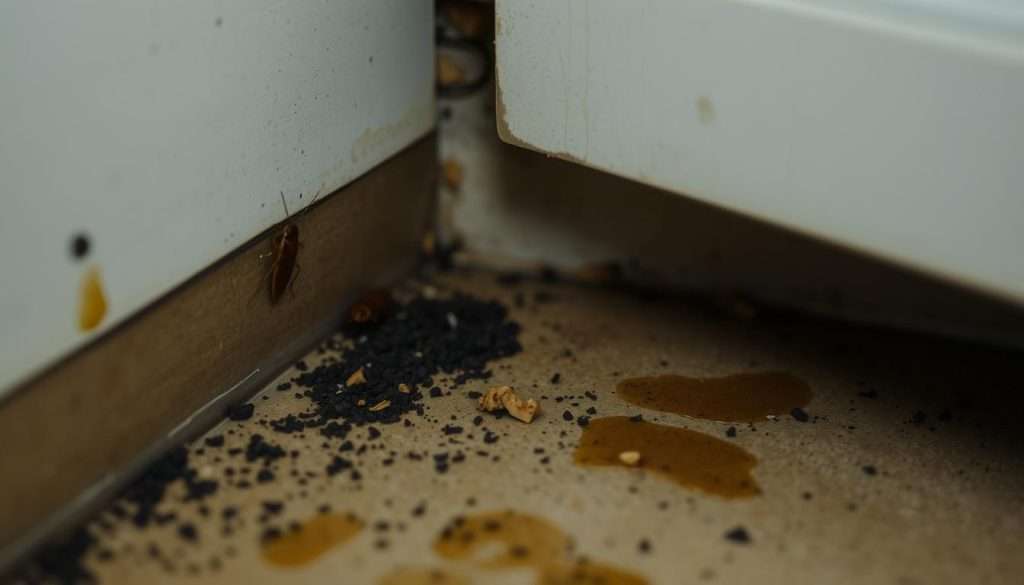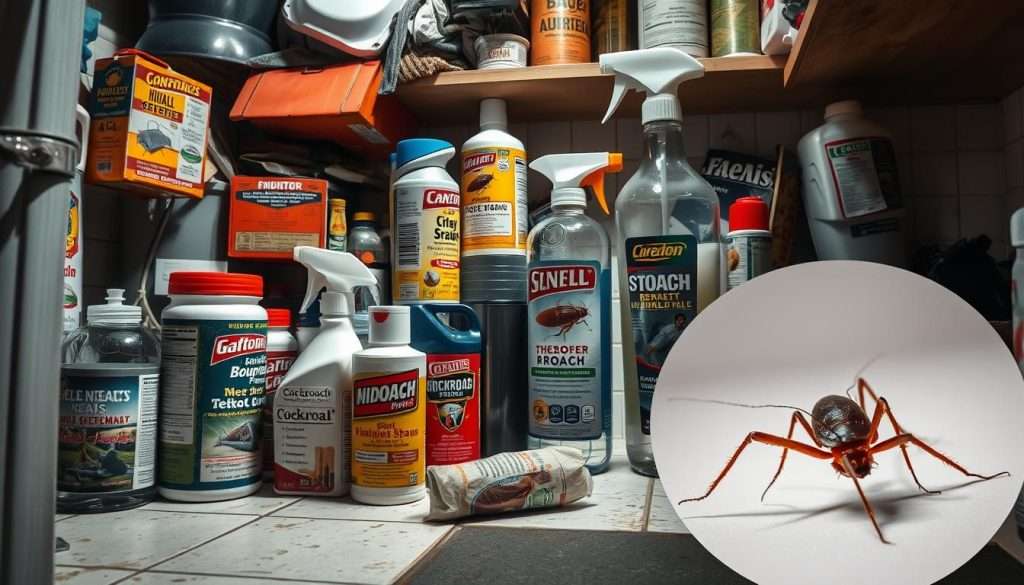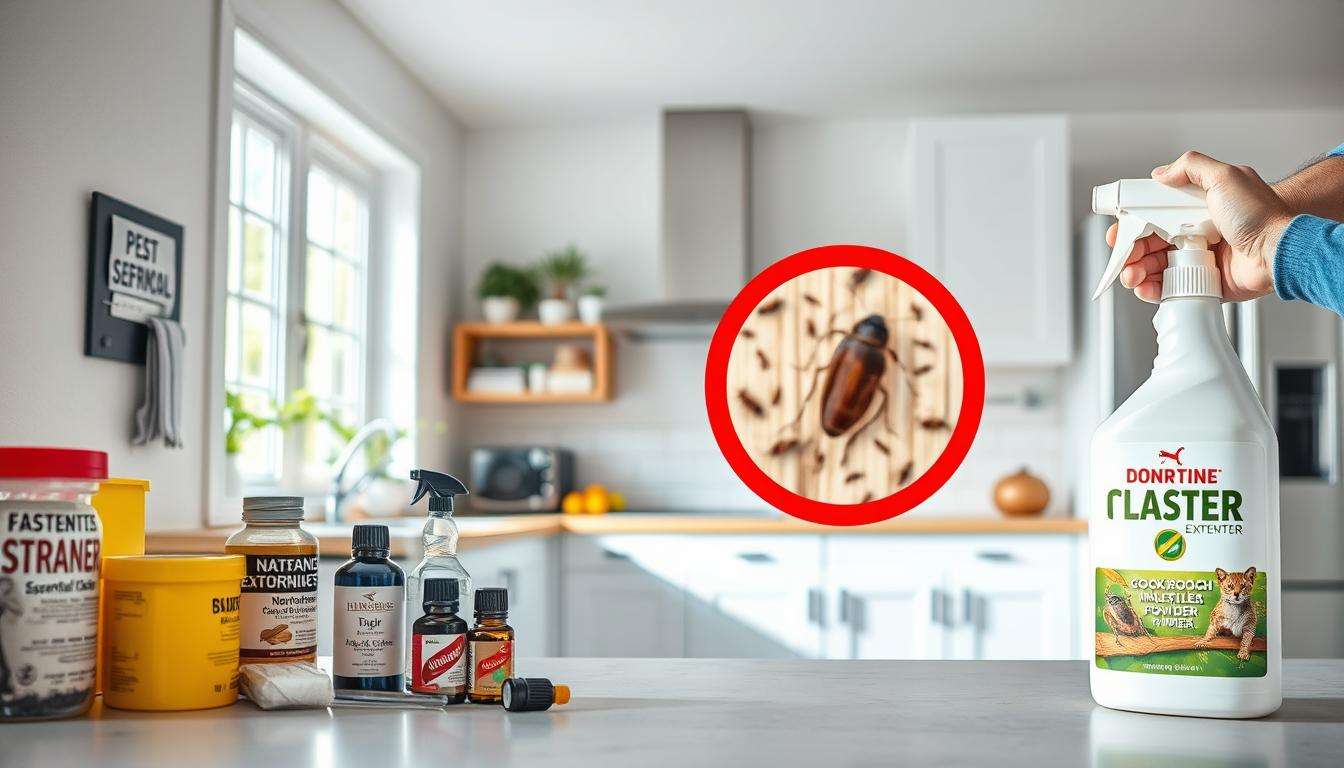Cockroaches are a nightmare for homeowners. They are oval-shaped, brown or tan, and quickly form colonies. With 69 species in the U.S., knowing their behavior is key to control. This guide will help you fight these pests with practical solutions.
We’ll cover health risks, how to identify them, extermination methods, and prevention. We’re here to help you every step of the way.
Key Takeaways
- Cockroaches are nocturnal and prefer dark, secluded areas.
- They can spread diseases and trigger allergies through contaminants.
- Effective cockroach control includes thorough cleaning and sealing entry points.
- Identifying the type of cockroach is crucial for targeted extermination.
- Professional pest control services can offer the most reliable solutions when needed.
- Regular maintenance greatly reduces the risk of infestations.
Understanding Cockroaches and Their Risks
Cockroaches are more than just pests. They are serious cockroach health risks. These insects live in dirty places and cause health problems. Knowing the dangers helps keep your home safe.
Common Diseases Spread by Cockroaches
Cockroaches carry many sickness-causing germs. They spread:
- Salmonella
- Dysentery
- Typhoid fever
- Cholera
- Leprosy
- Plague
- Poliomyelitis
- E. coli
Studies show they carry 33 types of bacteria and many worms. Knowing about diseases caused by cockroaches helps avoid health problems. This is especially true in cities where they are more common.
Why Cockroaches Are a Health Hazard
Cockroaches in your home can cause health issues. Their droppings and saliva are main culprits. These can make allergies and asthma worse, leading to symptoms like:
- Skin rashes
- Coughing
- Wheezing
- Nasal congestion
- Ear infections
- Sinus infections
The cockroach infestation dangers go beyond allergies. They can spread bacteria, making food and areas unsafe. Keeping clean and dealing with infestations fast is key to avoiding these risks.
Signs of a Cockroach Infestation
Spotting cockroach signs early helps take action fast. Let’s explore how to spot cockroaches and what to look for.
Visible Signs of Cockroaches
Some key signs of cockroach infestation include:
- Sightings of live or dead roaches, often larger than an inch and a half, especially in dark and humid areas.
- Presence of discarded exoskeletons, which roaches shed 5 to 8 times as they mature.
- Finding red-brown or brown smear marks in areas of high moisture.
- Observation of activity during the daytime, which suggests a significant infestation.
Identifying Roach Droppings and Odors
When trying to understand how to identify cockroaches, pay close attention to their droppings and any unusual smells. Here’s what to look for:
- Cockroach droppings can vary in appearance; smaller feces resemble coffee grounds or black pepper, while larger ones are cylindrical pellets.
- A musty, oily odor often accompanies larger infestations, indicating the need for immediate action.
- Roaches leave behind egg capsules that can be segmented and are typically brown or red in color, indicating a potential breeding ground nearby.

Since a female cockroach can carry up to 30 nymphs in her egg case, the presence of one roach often indicates several more are lurking close by. It’s advisable to call an exterminator at the first signs of a cockroach infestation to prevent it from escalating.
How to Get Rid of Cockroach: Step-by-Step Guide
To get rid of cockroaches, you need a plan. Start by figuring out what kind of cockroach you have. This helps you pick the right way to treat them. Different cockroaches behave and live in different ways.
Knowing if you have a German or American cockroach helps a lot. This knowledge shapes your plan to get rid of them.
Identifying the Type of Cockroach
First, look for signs of the cockroach type. German cockroaches are small and brown, living mostly indoors. American cockroaches are bigger and reddish-brown, preferring the outdoors.
Watching where you see them helps you find where they live.
Choosing the Right Treatment Method
After figuring out the type, pick a treatment. You might use:
- Chemical insecticides made for certain roach types.
- Non-chemical options like natural repellents or barriers.
- Boric acid in hidden spots where roaches nest.
Each method works differently based on the roach’s habits. Always follow safety rules when using chemicals.
Utilizing Traps and Baits Effectively
Traps and baits are key in fighting cockroaches. Use traps to see if your treatment is working. Place baits where roaches are likely to pass by.
Adhesive traps help you see how bad the problem is. This tells you what to do next.
| Treatment Method | Effectiveness | Application Notes |
|---|---|---|
| Chemical Insecticides | High | Use as directed; keep away from kids and pets. |
| Boric Acid | Moderate | Works well in hidden spots; keep pets away. |
| Cockroach Traps | Variable | Check traps often to see how bad it is. |
| Natural Repellents | Low | Use to keep them away, not as the main fix. |
Being proactive helps a lot. Each method plays a part in making your home roach-free.
Effective Cockroach Extermination Techniques
When you face a cockroach problem, picking the right extermination methods is key. We’ll look at different ways to get rid of these pests from your home.
Using Chemical Insecticides Safely
Chemical insecticides are often used to kill cockroaches because they work well. It’s important to use these products carefully to keep your family safe. Always read and follow the instructions on the label before you use them. Some good insecticides for cockroach control include:
- Boric acid dust
- Gel baits (e.g., Combat, Maxforce)
- Insect growth regulators
Put these products in places where cockroaches hide, like behind appliances and in cracks. Also, use them near where food is stored.
Non-Chemical Methods of Cockroach Control
There are safe ways to deal with cockroach problems without chemicals. These options are good for those who don’t want to use chemicals. Here are a few:
- HEPA vacuums for quick cleanup
- Traps to catch and track roaches
- Boric acid powder for key areas
Using non-chemical methods helps control cockroaches and is better for the environment. They work well when used with other methods.
When to Call a Professional Exterminator
If cockroaches keep coming back, even after you try to get rid of them, it’s time to call pest control. Experts have the knowledge and tools to solve the problem. They can give a detailed plan and use methods that last.
Act fast because cockroaches can quickly grow in numbers. If you need help, don’t wait to call an expert.

| Method | Description | Effectiveness | Safety |
|---|---|---|---|
| Chemical Insecticides | Common pest control products used in problem areas. | High | Follow label instructions for safety. |
| Gel Baits | Slow poison that roaches eat, helps lower numbers. | High | Safe for pets if used correctly. |
| Boric Acid | Powder used in hiding spots, works with cockroach biology. | Moderate | Generally safe, but avoid touching. |
| Traps | Devices to catch and track cockroach activity. | Moderate | Non-toxic and easy to use. |
| Professional Extermination | Expert services with advanced methods. | Very High | Experts handle all safety concerns. |
Integrated Pest Management for Cockroaches
Managing cockroach populations needs a smart plan called Integrated Pest Management (IPM). This method uses many ways to fight cockroach problems. It aims to protect people and the environment.
It mixes biological, cultural, physical, and chemical methods. This makes it a flexible solution.
Understanding Integrated Pest Management (IPM)
IPM focuses on knowing the cockroach type. For example, German cockroaches love living in big buildings and grow fast. It’s key to understand their habits and traits.
Regular checks and watching for signs are key parts of a good IPM plan.
Sanitation Practices to Prevent Infestations
Good sanitation is key to stopping cockroach problems. By removing food and hiding spots, you can lower the risk of infestations. Here are some important sanitation tips:
- Keep food areas clean and make sure no food is left out.
- Seal any cracks and openings in walls to reduce entry points.
- Dispose of garbage quickly and keep it sealed.
- Store food in airtight containers.
Using these sanitation tips in your IPM plan can make your space healthier. It also lowers the risk of cockroach issues.
Preventing Future Cockroach Infestations
To stop cockroaches, focus on two key steps. First, seal all entry points. Second, keep your home clean and free of clutter. These actions can greatly lower the risk of roach problems.
How to Seal Entry Points
Sealing cockroach entry points is crucial. Here are some ways to protect your home:
- Check and replace old weather stripping around doors and windows.
- Seal cracks and crevices in walls with strong caulking, especially around windows and doors.
- Make sure gaps around pipes and light fixtures are sealed tight.
- Fix cracks in the foundation quickly.
- Keep your yard tidy by trimming bushes and plants to reduce hiding spots.
- Store firewood at least one foot away from your home walls.
- Keep mulch about six inches away from your foundation to block access.
Maintaining a Clean and Clutter-Free Environment
Keeping your home clean is also key to preventing cockroaches. Follow these tips for a clean home:
- Clean pantries and cabinets often to get rid of crumbs and spills.
- Use airtight containers to store food and keep it away from roaches.
- Wipe down counters every day to remove food bits.
- Empty trash cans regularly to avoid attracting roaches.
- Fix any leaks in pipes or faucets to reduce water sources.
- Dry kitchen and bathroom sinks each night to keep roaches away.
- Declutter often to reduce places for roaches to hide.
- Vacuum weekly to get rid of any food that roaches might find.
Using Cockroach Pesticides Wisely
Managing cockroach populations well needs a smart plan for using pesticides. These products can really cut down on roach numbers if used right. Always follow the label on the pesticide to keep your family and pets safe. Here are some tips for using pesticides well:
- Targeted applications: Aim for spots where roaches are seen, like kitchens and bathrooms. This cuts down on exposure in other parts of your home.
- Baits and traps: Use cockroach baits with slow-acting poisons and food. They help kill roaches over time, lowering their numbers.
- Monitor effectiveness: Watch how your pesticide use is working. If roaches are still around, you might need more treatments.
Natural options like Boric Acid and Diatomaceous Earth work well in hard spots and are safe. Ethanol kills roaches on contact, and white vinegar repels them and cleans surfaces. Cleaning with white vinegar can stop roach problems.
For a full solution, consider professional pest control services like Preventive Pest Control. They have over 20 years of experience in Orange County and the Inland Empire. They use top-notch cockroach pesticides not available to everyone.
Conclusion
Our guide to cockroach control shows why it’s key to know about these pests. It’s important to spot signs early and use good control and prevention. Cockroaches can live a long time without food and have lots of babies fast.
Keeping your place clean and sealing holes helps a lot. Using boric acid, baking soda, and diatomaceous earth can also work. If you need help, pest control pros can find and get rid of cockroaches, especially in kitchens.
By using what we’ve talked about, you can keep your home cockroach-free. For more tips on getting rid of cockroaches, check out this ultimate guide to cockroach control. Take action to protect your home.
